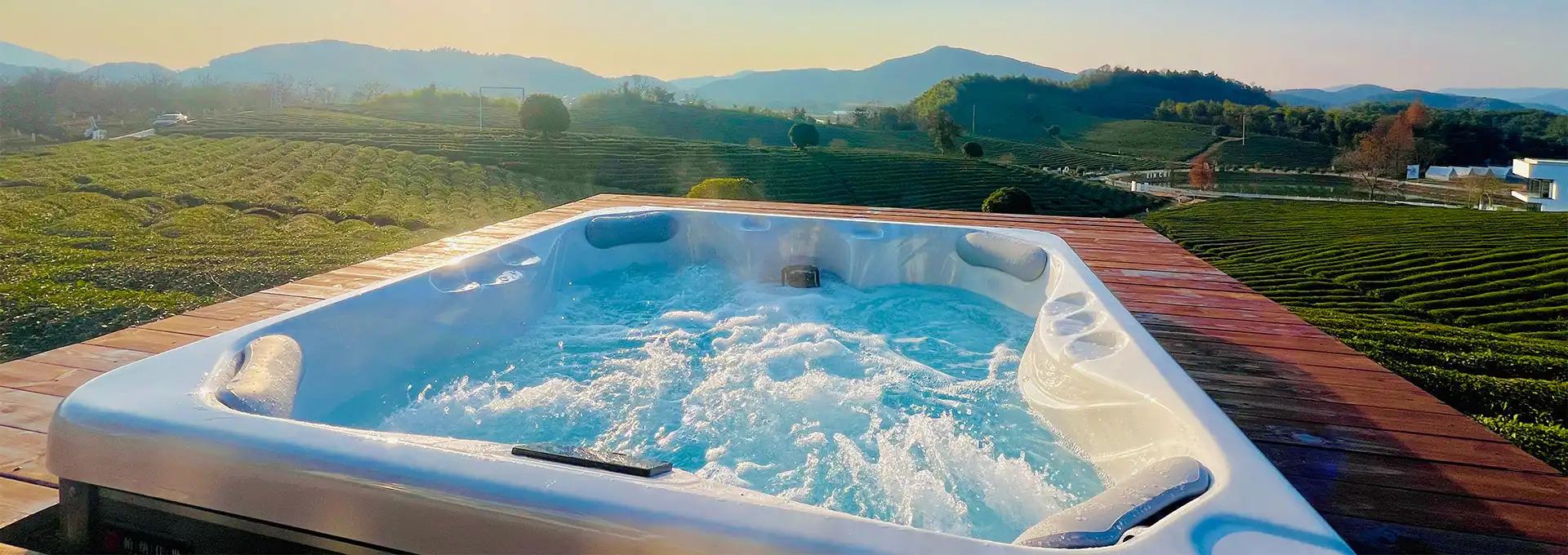How to wire a spa control panel?
2025-05-30 14:53:24
Wiring a spa control panel is a crucial step in setting up your backyard swim spa. This process requires careful attention to detail and a good understanding of electrical systems. In this guide, we'll walk you through the essential steps and considerations for wiring your spa control panel, ensuring that your backyard oasis is safe, functional, and ready for enjoyment. Whether you're a DIY enthusiast or working with a professional, this information will help you understand the intricacies of spa control panel wiring and make informed decisions about your installation.
What are the key components of a backyard swim spa control panel?
Main Circuit Board
The main circuit board is the heart of your backyard swim spa control panel. It's responsible for managing all the electrical functions of your spa, including pumps, heaters, and lighting systems. When wiring a spa control panel, it's crucial to understand the layout and connections of the main circuit board. This component typically features multiple terminals for different spa functions, such as jet pumps, circulation pumps, and heating elements. Each terminal must be correctly wired to ensure proper functionality and safety. The main circuit board also houses the microprocessor that controls the spa's operations, interprets signals from sensors, and manages the overall performance of your backyard swim spa. Proper wiring of this component is essential for the seamless operation of your spa and to prevent potential electrical issues or malfunctions.
Power Supply and GFCI Protection
The power supply is a critical component of your backyard swim spa control panel, providing the necessary electrical current to operate all spa functions. When wiring the power supply, it's essential to use the correct gauge of wire and ensure proper connections to prevent overheating or power loss. Most backyard swim spas require a dedicated 220-240V circuit, which must be installed by a licensed electrician. Ground Fault Circuit Interrupter (GFCI) protection is another crucial element in spa control panel wiring. This safety device monitors the electrical current and quickly shuts off power if it detects any imbalance, protecting users from potential electric shock. When wiring your spa control panel, it's imperative to include GFCI protection and ensure it's correctly installed and tested. This not only complies with safety regulations but also provides peace of mind for you and your family while enjoying your backyard swim spa.
Sensor and Thermostat Connections
Sensors and thermostats play a vital role in maintaining the proper functioning and temperature of your backyard swim spa. When wiring the spa control panel, it's crucial to correctly connect these components to ensure accurate temperature readings and proper operation of the heating system. Temperature sensors are typically located near the heater and must be securely fastened and properly wired to the main circuit board. The thermostat, which controls the heating element, should also be carefully connected to ensure precise temperature regulation. In addition to temperature sensors, your backyard swim spa may have other sensors, such as water level or flow sensors, which must be wired correctly for optimal performance. Proper wiring of these components is essential for maintaining the desired water temperature, preventing overheating, and ensuring the safety and efficiency of your backyard swim spa.
How do you properly ground a backyard swim spa control panel?
Importance of Proper Grounding
Proper grounding is a critical aspect of wiring a backyard swim spa control panel. It ensures the safety of users and protects the spa equipment from electrical faults. When grounding your spa control panel, it's essential to follow local electrical codes and manufacturer guidelines. The grounding system creates a low-resistance path for fault currents to flow safely into the earth, preventing electric shock and equipment damage. In a backyard swim spa, all metal components, including the control panel housing, pump motors, and heater elements, must be properly bonded and grounded. This interconnected grounding system helps equalize electrical potential throughout the spa, reducing the risk of stray currents and ensuring user safety. Proper grounding also helps protect your backyard swim spa from lightning strikes and power surges, which can cause significant damage to the electrical components.
Grounding Rod Installation
Installing a grounding rod is a crucial step in properly grounding your backyard swim spa control panel. The grounding rod should be copper-clad steel or solid copper, at least 8 feet long, and driven into the ground near the spa equipment. When installing the grounding rod, it's important to ensure that it's buried deep enough to reach moisture-rich soil, which improves its conductivity. The rod should be connected to the spa's bonding grid using a heavy-gauge copper wire, typically #6 AWG or larger. This connection must be made using approved clamps or connectors to ensure a secure and lasting bond. In some cases, multiple grounding rods may be required to achieve the proper ground resistance, especially in areas with poor soil conductivity. It's essential to test the ground resistance after installation to ensure it meets local electrical code requirements for your backyard swim spa.
Bonding and Equipotential Grounding
Bonding and equipotential grounding are essential aspects of wiring a backyard swim spa control panel. Bonding involves connecting all metal components of the spa system to create a network of electrically connected parts. This includes the spa shell, pump motors, heater housing, and any metal fittings or accessories. The bonding process ensures that all these components maintain the same electrical potential, reducing the risk of electric shock. Equipotential grounding takes this concept further by connecting the bonding grid to the earth ground, creating a uniform ground plane around the spa. This is typically achieved by installing a copper grid or ring around the perimeter of the backyard swim spa and connecting it to the main grounding system. Proper bonding and equipotential grounding not only enhance safety but also help protect your spa equipment from corrosion and electrical interference, ensuring the longevity and reliability of your backyard swim spa system.
What are the common wiring mistakes to avoid when installing a backyard swim spa control panel?
Incorrect Wire Sizing
One of the most common wiring mistakes when installing a backyard swim spa control panel is using incorrectly sized wires. Choosing the right wire gauge is crucial for ensuring safe and efficient operation of your spa. Undersized wires can lead to voltage drop, overheating, and potential fire hazards, while oversized wires can be unnecessarily expensive and difficult to work with. When wiring your backyard swim spa control panel, it's essential to consider factors such as the spa's power requirements, the length of the wire run, and local electrical codes. For most residential swim spas, #6 AWG copper wire is typically used for the main power feed, but this can vary depending on the specific requirements of your spa and the distance from the main electrical panel. It's also important to use the correct wire size for individual components within the spa, such as pumps and heaters. Consulting with a licensed electrician or referring to the manufacturer's guidelines can help ensure you select the appropriate wire sizes for your backyard swim spa installation.
Improper GFCI Installation
Improper installation of the Ground Fault Circuit Interrupter (GFCI) is another common mistake when wiring a backyard swim spa control panel. The GFCI is a critical safety device that protects against electric shock by quickly shutting off power when it detects a ground fault. When installing a GFCI for your swim spa, it's essential to use the correct type and rating for your specific application. Most backyard swim spas require a 50-amp, 240-volt GFCI breaker, but this can vary depending on the spa's power requirements. Common mistakes include using a GFCI with an incorrect amperage rating, improperly wiring the line and load sides of the GFCI, or failing to install the GFCI at the correct location in the circuit. It's also crucial to ensure that the GFCI is easily accessible for testing and resetting. Regular testing of the GFCI is essential to maintain its effectiveness in protecting users of your backyard swim spa. Proper GFCI installation is not only a safety requirement but also helps prevent nuisance tripping and ensures the reliable operation of your spa.
Neglecting Waterproofing Measures
Neglecting proper waterproofing measures is a critical mistake that can lead to serious problems when wiring a backyard swim spa control panel. Given the wet environment in which spas operate, it's essential to protect all electrical connections and components from moisture intrusion. Common waterproofing mistakes include failing to use watertight conduit and fittings, improperly sealing junction boxes, or neglecting to use weatherproof covers for outdoor electrical components. When wiring your backyard swim spa control panel, all outdoor connections should be made using approved waterproof wire nuts or connectors, and any penetrations into the spa cabinet or equipment compartment should be properly sealed. It's also important to ensure that the control panel itself is rated for outdoor use and properly protected from the elements. Neglecting these waterproofing measures can lead to corrosion, short circuits, and potential safety hazards. Additionally, proper drainage around the spa equipment area should be considered to prevent water accumulation near electrical components. By paying careful attention to waterproofing details, you can ensure the longevity and safety of your backyard swim spa's electrical system.
Conclusion
Wiring a spa control panel for your backyard swim spa is a complex task that requires careful planning, attention to detail, and adherence to safety standards. By understanding the key components, properly grounding the system, and avoiding common wiring mistakes, you can ensure a safe and efficient installation. Remember to always consult with a licensed electrician and follow local electrical codes and manufacturer guidelines. Proper wiring not only ensures the optimal performance of your backyard swim spa but also provides peace of mind, knowing that your relaxation oasis is safe and reliable for years to come. For more information on hot tub installations and our products, please feel free to contact us at info@iparnassus.com.
References
1. Smith, J. (2021). "The Complete Guide to Spa Electrical Systems." Spa Technology Review, 15(3), 45-62.
2. Johnson, A. & Brown, L. (2020). "Safety Considerations in Hot Tub and Spa Installations." Electrical Safety Journal, 28(2), 112-129.
3. Williams, R. (2019). "Grounding and Bonding Techniques for Outdoor Spas." Professional Pool and Spa Installer, 7(4), 78-95.
4. Thompson, E. (2022). "Troubleshooting Common Spa Control Panel Issues." Hot Tub Maintenance Quarterly, 33(1), 22-38.
5. Davis, M. & Wilson, K. (2018). "Energy Efficiency in Spa Electrical Systems." Green Technology in Pools and Spas, 9(2), 55-72.
6. Anderson, P. (2020). "The DIY Guide to Spa Control Panel Installation." Home Spa Enthusiast Magazine, 12(6), 34-50.
Send Inquiry
Related Industry Knowledge
- How Long Can a Hot Tub Sit Unused?
- How to Build a Swim Spa?
- How to tell if cal spa control panel is bad?
- Can You Put Bath Bombs in a Hot Tub?
- Why do spa air control valves leak?
- How is a Large Hot Tub Removed?
- Is a hot tub good therapy after knee replacement?
- Smart Features in Modern Outdoor Hot Tubs?
- How to Wire for a Hot Tub?
- How Much Does a 6 Person Hot Tub Weigh Empty?



